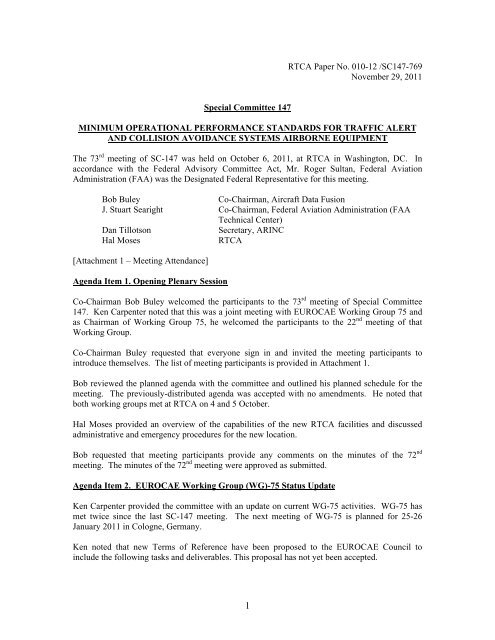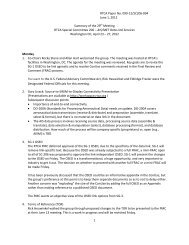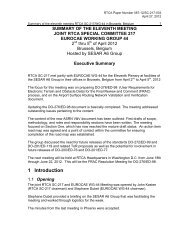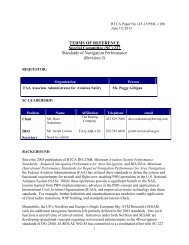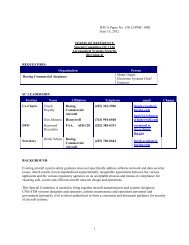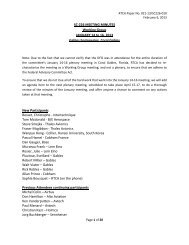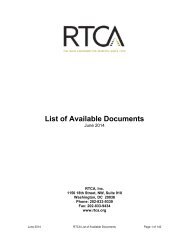Create successful ePaper yourself
Turn your PDF publications into a flip-book with our unique Google optimized e-Paper software.
Special Committee 147<br />
1<br />
<strong>RTCA</strong> Paper No. 010-12 /SC147-769<br />
November 29, <strong>2011</strong><br />
MINIMUM OPERATIONAL PERFORMANCE STANDARDS FOR TRAFFIC ALERT<br />
AND COLLISION AVOIDANCE SYSTEMS AIRBORNE EQUIPMENT<br />
The 73 rd meeting of SC-147 was held on <strong>October</strong> 6, <strong>2011</strong>, at <strong>RTCA</strong> in Washington, DC. In<br />
accordance with the Federal Advisory Committee Act, Mr. Roger Sultan, Federal Aviation<br />
Administration (FAA) was the Designated Federal Representative for this meeting.<br />
Bob Buley Co-Chairman, Aircraft Data Fusion<br />
J. Stuart Searight Co-Chairman, Federal Aviation Administration (FAA<br />
Technical Center)<br />
Dan Tillotson Secretary, ARINC<br />
Hal Moses <strong>RTCA</strong><br />
[Attachment 1 – Meeting Attendance]<br />
Agenda Item 1. Opening Plenary Session<br />
Co-Chairman Bob Buley welcomed the participants to the 73 rd meeting of Special Committee<br />
147. Ken Carpenter noted that this was a joint meeting with EUROCAE Working Group 75 and<br />
as Chairman of Working Group 75, he welcomed the participants to the 22 nd meeting of that<br />
Working Group.<br />
Co-Chairman Buley requested that everyone sign in and invited the meeting participants to<br />
introduce themselves. The list of meeting participants is provided in Attachment 1.<br />
Bob reviewed the planned agenda with the committee and outlined his planned schedule for the<br />
meeting. The previously-distributed agenda was accepted with no amendments. He noted that<br />
both working groups met at <strong>RTCA</strong> on 4 and 5 <strong>October</strong>.<br />
Hal Moses provided an overview of the capabilities of the new <strong>RTCA</strong> facilities and discussed<br />
administrative and emergency procedures for the new location.<br />
Bob requested that meeting participants provide any comments on the minutes of the 72 nd<br />
meeting. The minutes of the 72 nd meeting were approved as submitted.<br />
Agenda Item 2. EUROCAE Working Group (WG)-75 Status Update<br />
Ken Carpenter provided the committee with an update on current WG-75 activities. WG-75 has<br />
met twice since the last SC-147 meeting. The next meeting of WG-75 is planned for 25-26<br />
January <strong>2011</strong> in Cologne, Germany.<br />
Ken noted that new Terms of Reference have been proposed to the EUROCAE Council to<br />
include the following tasks and deliverables. This proposal has not yet been accepted.
1. Update Existing MOPS for TCAS II<br />
2. Prepare MOPS for TCAS Hybrid Surveillance<br />
3. Develop MOPS for Autoflight/TCAS Coupling<br />
4. Develop guidance for traffic displays that support collision avoidance for aircraft not<br />
carrying TCAS II<br />
5. Define proposals to support the development of future collision avoidance systems<br />
Ken noted that Working Group 75 had no plans to change the core TCAS II MOPS other than in<br />
unison with SC-147, and that MOPS for TCAS II and Hybrid Surveillance are expected to be<br />
identical to the <strong>RTCA</strong> MOPS.<br />
The primary focus of the initial work on developing MOPS for the Autoflight/TCAS Coupling<br />
will be in the areas of automatic guidance on RAs and altitude capture adaptation to reduce<br />
occurrence of RAs. It is expected that a new subgroup will be established to complete this work<br />
to ensure that appropriate expertise in autoflight systems is included in the work. Analyses have<br />
shown that the collision risk will be reduced by a factor of two and the RA rate reduced by over<br />
50% in European airspace with the implementation of the autoflight/TCAS coupling. Ken<br />
expressed the desire from Working Group 75 to have the development of these MOPS be done in<br />
concert with <strong>RTCA</strong>.<br />
The SC-147 Co-Chairs outlined the process needed to have the efforts on MOPS development to<br />
become a joint effort. Bob Buley expressed his desire that the appropriate expertise from SC-147<br />
be involved in any joint work, regardless of which <strong>RTCA</strong> Special Committee eventually is tasked<br />
with working with Working Group 75.<br />
Working Group 75 has also been working on the compatibility of TCAS with ground safety nets<br />
and the display of RA information to controllers. The Requirements Working Group (RWG)<br />
spent some time during their meeting this week discussing the display of RA information to<br />
controllers.<br />
Ken introduced two presentations on the topic display of RA information to controllers:<br />
� Yvonne Graner clarified DFS's motivation to perform significant research on this topic<br />
following the Überlingen accident and an associated safety recommendation. She<br />
outlined the DFS program for evaluating the use of this information, and the enabling<br />
technology.<br />
� Stan Drozdowski started by placing the display of RA information in the broader context<br />
of Compatibility of Safety Nets. He provided an overview of ATS facilities where Mode<br />
S RA downlink is already being used to display RA information to controllers although<br />
there are no ICAO provisions for the operation of RA downlink. He concluded by<br />
advocating a more holistic approach to further TCAS evolution.<br />
Agenda Item 3. TCAS Program Office Activities<br />
Neal Suchy provided an overview of the work being performed by the TCAS Program Office to<br />
define potential next generation collision avoidance system. Work is also underway to<br />
investigate the display of RA information to controllers. At the present time, the Program Office<br />
does not support the display of information to controllers.<br />
Agenda Item 3.a Monitoring Efforts/TRAMS/TOPA<br />
2
Wes Olson provided an overview of data collected and analyzed as part of the TCAS Operational<br />
Assessment Program (TOPA). He noted that a majority of the data are being collected from<br />
Mode S radars across the United States. There are 21 sites now operational and there are<br />
currently over 150,000 RAs in the TOPA database. There has been little change in the findings<br />
from the data since his report at the last SC-147 meeting.<br />
Wes presented an overview of studies and analyses that have been completed on pilot response to<br />
RAs; TCAS performance in level off encounters (with both 500 and 1000 ft separation from the<br />
intruder); and RAs issued where an intruder could not be identified in the radar surveillance data.<br />
Agenda Item 3.b Future Collision Avoidance System (CAS) Development Efforts<br />
Neal Suchy provided an overview of the work being performed by the TCAS Program Office to<br />
define potential next generation collision avoidance system. The Program Office’s efforts are<br />
focused on three primary work packages.<br />
1. Improve current surveillance performance to minimize TCAS utilization of the<br />
1030/1090 MHz spectrum.<br />
2. Develop threat logic that will be compatible with expected/planned changes in airspace<br />
structure and operations. This threat logic is focused for use on aircraft that currently use<br />
TCAS II systems.<br />
3. Define surveillance requirements and concepts that will allow TCAS to use different<br />
surveillance sources and use improved tracking algorithms.<br />
Additional research is being conducted to evaluate requirements and concepts that could provide<br />
a collision avoidance capability for other classes of airspace users.<br />
Work is underway to conduct initial flight testing of the new threat logic in the 2013 time frame.<br />
Agenda Item 4 AVS and Other FAA Activities<br />
Agenda Item 4.a Certification and Flight Standard Activities<br />
Roger Sultan provided an update on the TCAS-related activities that Flight Standards have been<br />
working on since the last Plenary meeting.<br />
The Flight Standards’ Outreach efforts have resulted in meetings and discussions with NetJets<br />
and Boeing’s Training organization. The next efforts for the Outreach program are to conduct<br />
briefings at NBAA Regional Forums and with ALPA.<br />
A SAFO has been developed for Part 135 and Part 91k operators related to TCAS training and<br />
guidance. This is in final review and is expected to be released shortly.<br />
Flight Standards is also working on developing TCAS training material and has supported<br />
verification of the implementation of the autopilot and flight director automated response systems<br />
on the A350.<br />
Roger introduced Wayne Gallo to the Committee. Wayne is a new member of the Flight<br />
Standards Organization and will be representing Flight Standards in future SC-147 meetings.<br />
3
Agenda Item 4.b ASIAS/CAST/CAS Steering Committee<br />
There were no discussions under this agenda item.<br />
Agenda Item 5. Working Group Status Reports<br />
Agenda Item 5.a Requirements Working Group (RWG)<br />
Andy Zeitlin provided a summary of the RWG’s work since the last Plenary meeting. The main<br />
focus is preparing a report on future collision avoidance systems and work on that report has been<br />
completed. Andy’s report provided an overview of the contents and recommendations from the<br />
report. The report identifies both near-term and long-term improvements that could be<br />
incorporated into the collision avoidance logic.<br />
The contents of the report were reviewed this week by the RWG and the RWG is in agreement<br />
with the current version of the report. Following the completion of a few editorial cleanup<br />
changes, the report will be ready for distribution to the Committee for review and comment.<br />
To support the delivery of the report to the Program Management Committee (PMC) in<br />
December <strong>2011</strong>, the following distribution and review schedule was agreed to during the<br />
meeting.<br />
Initial Distribution <strong>October</strong> 19, <strong>2011</strong><br />
Comments Due Back to Andy November 7, <strong>2011</strong><br />
Telecon/Webex to Review Comments November 9, <strong>2011</strong><br />
Deliver to PMC November 30, <strong>2011</strong><br />
Agenda Item 5.b Surveillance Working Group (SWG)<br />
Ruy Brandao provided a status report on the SWG’s work. Since the last SC-147 meeting, work<br />
has continued to develop and evaluate means of reducing the TCAS utilization of the 1090 MHz<br />
frequency. A simulation model that was previously developed was updated to incorporate all six<br />
specific change proposals and testing was done with all of the various proposals. Simulations<br />
show that Changes to DO-300 would result in 1090 MHz utilization reduction of 60% to 85%<br />
when all simulated TCAS II equipped aircraft have these changes implemented. Additional<br />
change proposals have been defined which would further reduce the contributions of on-ground<br />
TCAS to 1090 MHz utilization. Evaluation of the benefits of these changes is expected to be<br />
complete by the end of the year. Safety studies do not show any degradation in risk ratio when<br />
these changes are implemented.<br />
The SWG recommended that the Terms of Reference be amended to allow incorporation of these<br />
changes in the MOPS. The SWG will continue work on the change proposals under the<br />
assumption that the Terms of Reference will be updated. This may result in changes to DO-<br />
185B, DO-300, or both.<br />
The SWG also proposed allowing TAs to be issued based solely on ADS B data (for hybrid<br />
surveillance equipped aircraft) if the intruder was not already being interrogated and then<br />
switching to active interrogations immediately after the TA was issued. The Committee agreed<br />
with this proposal.<br />
4
The SWG also sought the Committee’s input on a change proposal to limit, in surveillance, the<br />
tracking of aircraft within 3000 feet above the airport surface when TCAS is operated while the<br />
own aircraft is on the ground. There were no objections to this proposal and no concerns were<br />
expressed with such an implementation.<br />
The Co-Chairs agreed to caucus on how to handle proposing these change proposals to the PMC.<br />
The Co-Chairs will distribute the results of their discussions, along with their recommendations,<br />
to the Committee in the same time frame that the RWG report is distributed.<br />
Agenda Item 6 Consideration of Final Proposed Changes to SC-147 Terms of Reference<br />
There were no specific discussions conducted under this agenda item.<br />
Agenda Item 7 Other Business<br />
Agenda Item 7.a Traffic Situational Awareness with Alerts (TSAA) Status<br />
Dave Gray presented an overview of the of the SC-186 work to develop requirements and<br />
standards for TSAA. The Committee provided comments and feedback on the concept of TSAA<br />
and its operational use with the intent of ensuring that TSAA did not degrade the performance<br />
and safety provided by TCAS II.<br />
Agenda Item 8 Action Items<br />
There were no discussions under this agenda item.<br />
Agenda Item 9 Closing Session<br />
Agenda Item 9.a. Date and Time of Next Meeting<br />
All presentations from this meeting are available on the <strong>RTCA</strong>/SC-147 website or from <strong>RTCA</strong><br />
upon request.<br />
The next meeting of the Committee will be scheduled following the <strong>RTCA</strong> PMC meeting<br />
scheduled for December. The Co-Chairs will schedule this meeting once further guidance on the<br />
Committee’s proposals and recommendations is received from the PMC.<br />
Certified as a true and accurate summary of the meeting.<br />
Co-Chairmen<br />
-S- -S-<br />
Mr. Robert Buley Mr. Stuart Searight<br />
Aircraft Data Fusion FAA<br />
5
Attachment 1<br />
Meeting Attendance for SC-147 Plenary on <strong>October</strong> 6, <strong>2011</strong><br />
Name Organization E-mail<br />
Thierry Arino Egis Avia thierry.arino@egis.fr<br />
Christian Aveneau DSNA aveneau@cena.fr<br />
Larry Bachman Regulus Group LLC lbachman@regulus-group.com<br />
Ben Bakker EUROCONTROL ben.bakker@eurocontrol.int<br />
John Banzhaf USAF john.banzhaf.ctr@hanscom.af.mil<br />
Carl Bayh BAE Systems raymond.bayh@baesystems.com<br />
Walter Bender JHU/APL walter.r.bender@jhuapl.edu<br />
Ruy Brandao Honeywell International ruyjr.brandao@honeywell.com<br />
Robert Buley Aircraft Data Fusion bobbuley@aircraftdf.com<br />
Joslin Carino FAA joslin.carino@faa.gov<br />
Ken Carpenter QinetiQ ken@kencarpenter.co.uk<br />
Michael Castle Aurora Sciences LLC mcastle@aurorasciences.com<br />
Mark Cato Air Line Pilots Association catom@alpa.org<br />
Kathryn Ciaramella FAA kathryn.cairamella@faa.gov<br />
Robert Clarke Alion Science and Technology rclarke@alionscience.com<br />
Jonathan Dahlgren Honeywell jonathan.dahlgren@honeywell.com<br />
Stanislaw Drozdowski EUROCONTROL stanislaw.drozdowski@eurocontrol.int<br />
Ann Drumm MIT Lincoln Laboratory drum@ll.mit.edu<br />
Tomas Elder MIT Lincoln Laboratory tomas.elder@ll.mit.edu<br />
John Fisher FAA john.d.fisher@faa.gov<br />
Gaston Formisano Rockwell Collins cgformis@rockwellcollins.com<br />
Wayne Gallo FAA wayne.gallo@faa.gov<br />
Edward Glowacki Titan Corporation edward.ctr.glowacki@faa.gov<br />
Jose Goday ARINC jgoday@arinc.com<br />
Yvonne Graner DFS yvonne.graner@dfs.de<br />
David Gray FAA david.e.gray@faa.gov<br />
Carl Jezierski FAA carl.jezierski@faa.gov<br />
Jessica Holland MIT Lincoln Laboratory jessica.holland@ll.mit.edu<br />
Al Mattox ARINC amattox@arinc.com<br />
Ralph Mintel FAA ralph.mintel@faa.gov<br />
Matt Modderno FAA Matt.modderno@faa.gov<br />
Harold Moses <strong>RTCA</strong> hmoses@rtca.org<br />
Wesley Olson MIT Lincoln Laboratory wes.olson@ll.mit.edu<br />
Thomas Pagano FAA thomas.pagano@faa.gov<br />
Adam Panken MIT Lincoln Laboratory adam.panken@ll.mit.edu<br />
Chuck Rose MIT Lincoln Laboratory c.rose@ll.mit.edu<br />
Stacey Rowlan L-3 Communications stacey.rowlan@L-3com.com<br />
Stuart Searight FAA Technical Center stuart.searight@faa.gov<br />
Joshua Silbermann The Johns Hopkins University joshua.silberman@jhuapl.edu<br />
Charles Sloane FAA charles.sloane@faa.gov<br />
David Spencer MIT Lincoln Laboratory dspencer@ll.mit.edu<br />
Neal Suchy FAA neal.suchy@faa.gov<br />
Roger Sultan FAA roger.sultan@faa.gov<br />
William Thedford U.S. Air Force aacas-llc@comcast.net<br />
Dan Tillotson ARINC dtillots@arinc.com<br />
6
Name Organization E-mail<br />
Thomas Troast Regulas Group tetroast@regulas-group.com<br />
Jessie Turner Boeing jessie.turner@boeing.com<br />
Ethan Walters Aurora Sciences ewalters@aurorasciences.com<br />
Andrew Zeitlin MITRE Corporation/CAASD azeitlin@mitre.org<br />
7


